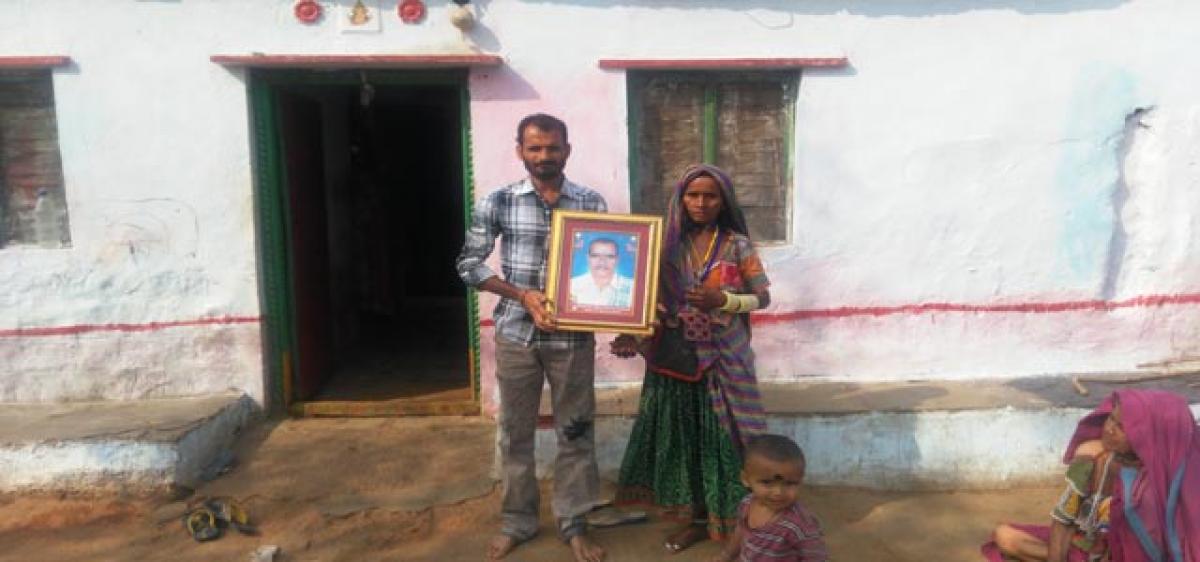Live
- Telangana Rejects Adani Foundation’s Rs.100 Crore CSR Grant for Young India Skills University
- Hebahstuns with timeless elegance
- Vijay Deverakonda's Rowdy Wear Shines as Iconic Indian Streetwear at Outlook India Business Awards 2024
- Manglishines bright with ‘Ustaad Bismillah Khan YuvaPuraskar’
- Time to make Indian GI-tagged products advance from ‘Gaon Se Global’: Minister
- PM Vishwakarma Yojana empowers women in J&K's Poonch to pursue self-employment
- ‘Kannappa’ release date announced at Shri Mahakaleshwar Temple in Ujjain
- PM Matsya Sampada Yojana opens doors of employment in Bihar’s Nalanda
- Japan's Saitama reports first bird flu outbreak this season
- ‘Srikakulam Sherlock Holmes’ to hit screens this Christmas
Just In

Having lost their crops during the past two consecutive years due to continuous drought, inadequate rains and crop failures, the farming community in the district is undergoing a sinister phase.
Mahbubnagar: Having lost their crops during the past two consecutive years due to continuous drought, inadequate rains and crop failures, the farming community in the district is undergoing a sinister phase. These factors have led to drastic reduction in agriculture yields and during the past two years, more than 280 farmers committed suicides in the four districts of erstwhile Mahbubnagar.
However, according to official records with the district administration, only 76 deaths of farmers were registered as agriculture-related suicides during the past two years and even among them only 53 farmers families have been given compensation, while the remaining are still in the investigation stage by the officials. “Since the formation of Telangana, we have registered 76 farmers’ suicides relating to agriculture debts and farming losses in the district.
Of them, we have already cleared compensation to 53 farmers while the other cases are pending due to delay in investigation by the concerned officials. Very soon we will also complete these enquires and submit the reports to the government,” informed a senior District Revenue Officer. If we look at the agriculture pattern for the year 2015-16, about 7.50 lakh acres of land has come under cultivation during Kharif, while about 1.10 lakh acres have been sown during the Rabi season.
But unfortunately, the district could not even receive 30 per cent rainfall during that year and the farmers had to face severe draught wherein they had to even struggle hard to get drinking water for humans while the condition of cattle and other livestock was even worse as they had to forcibly sell them to the slaughterhouses because of lack of water and fodder.
Even though the year 2016 had shown some respite with early good showers during the Kharif, it was also short lived with uneven rains. “After facing heavy losses in cotton crop during 2015, I thought of going for alternative crop and sowed maize over seven acres of land. However, though the initial germination was good, later the one month rain holiday dried up the entire crop.
Again there were some good showers later and I had to sow again the maize seeds. Though this experiment succeeded and the crop reached major stage again, 20 days of continuous rain halt hit severely the quality of yield. I lost almost Rs 1 lakh in maize crop this year,” explained Mudavath Shankar Chowan of MangaliKunta Thanda, of Jadcherla Mandal.
Not just the last two years, if one looks at the statistics of agriculture sector during the past 10 years, the farming community has been facing consecutive losses due to drought and inadequate rains. “During the last 10 years, we can say that agriculture sector has been facing severe losses for the past six consecutive years. Though the State government had announced crop loan waiver to farmers, it has not helped the farming community much,” says Nenavath Babya Nayak of Kotha Thanda.
According to rough estimates, it is estimated that the farmers in all four districts of Nagarkurnool, Wanaparthy, Gadwal and Mahbubnagar lost Rs 650 crore due to failure of agriculture. On an average, each farmer has a debt of Rs 50,000 to be paid to private lenders, in addition to the government loans from the banks.
By A Raju

© 2024 Hyderabad Media House Limited/The Hans India. All rights reserved. Powered by hocalwire.com







